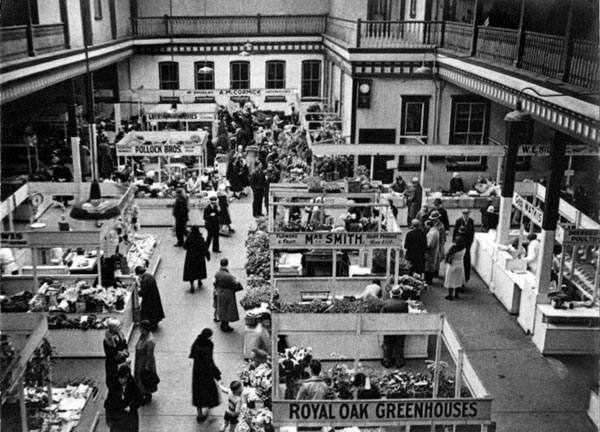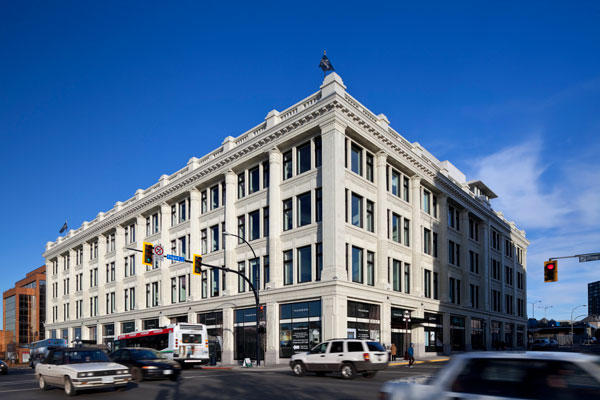On Sept. 14, Victoria consumers and local vendors will once again have a place to connect when the Victoria Public Market opens its doors at its brand-new home on Douglas Street.
More than 50 years have passed since the city's had such a market, and the new project, born of the rising wave of interest in all things local, is expected to fill the city's growing hunger for island-made goods. Support and anticipation for the market, say organizers, has been overwhelming. In other words, the timing is great.
In the past, it wasn't so great. When it comes to public markets, Victoria has a surprisingly long and dramatic history -- one rife with tales of growth, decay, renewal, possible arson, sensational standoffs with developers, and briefly, actual human corpses.
"Victoria had a vibrant public market until about 1960," explains Philippe Lucas, the chairman of the Victoria Downtown Public Market Society. "At that point it was torn down, and like in most of the western world shopping shifted to grocery stores and away from a farm market model. Over the last few years, of course, there's been a huge resurgence in people's desire to eat local -- both for reasons of food security, as well as the fact that local food just tastes better. If you don't have to bring your produce 3,000 miles, it's just going to be fresher and tastier."
The new 18,000-square-foot project is set to have its grand opening at The Hudson, the former Hudson's Bay Company store on Douglas Street, just in time for the building's 100th anniversary. The market will be open six days a week and already includes 11 permanent vendors and a community kitchen.
"About eight years ago, I started talking to local farmers to find out if they'd be interested in selling their product at a public market if we could get one in downtown Victoria again," Lucas explains. Thirty to 40 eager farmers stepped forward.
Over the next few years, Lucas, a former professional cook and city councillor, continued to gather "local food champions." His organization has been heavily involved in promoting local food production, hosting documentary screenings, public consultations, a year-round public market at the city's Market Square, and, each September, organizing EAT HERE NOW, an event that is by Lucas' estimation the single largest public market event on Vancouver Island, drawing more than 10,000 people per year.
Food for thought
In addition to featuring a near-dozen local food producers, including a seafood merchant and a baker, the market's Community Kitchen will feature demonstrations by local chefs and vendors, private cooking classes, kids programming, and will be available for low-cost rental to community groups interested in local food production.
In years to come, both Carmack and Lucas hope to foster the growth of not only a market but what Lucas calls a "socioeconomic engine." He hopes the market will not only build lasting relationships between producer and consumer, but also between vendors themselves, serving as a catalyst for serious discussion about local production and food security.
"We used to produce about 85 per cent of our food here on Vancouver Island," explains market manager Maryanne Carmack. "Now it's less than five. That's kind of a scary number when you think about it. I've heard stories of carting our animals off the island to be butchered in Vancouver, and then carting them back, and we do the same thing for other food, too. Sustainability is really important, especially for us on an island."
The conversation around island food security isn't new. In the last 100 years, the city of Victoria has tried several experiments to see whether markets can help boost local production.
The city's first market opened its doors in 1861, amid a storm of worry about dwindling local production and fears of competition from overseas imports. It was a privately-financed financed affair -- a decision which drew the ire of locals, and which may have contributed to its closure after only a few shaky months of operation. A second private venture in 1878 also met with failure.

The question of a city-owned public market building was brought before voters in January of 1887, and although vehemently supported by farmers and local papers such as the Daily Colonist, the proposal was soundly defeated.
"With a market the consumers will be brought face to face with the producers, and so avoid middlemen," the Colonist protested. "Not alone will the cost of living be lessened, but agriculturalists will be stimulated by better prices to renewed exertions. Few people are aware of the large quantities of farm produce that are brought to this port from abroad. It is quite possible by the judicious establishment of public markets in every municipality to reduce these amounts to the lowest possible point."
Market pressures
However, less than five years later voters had changed their minds and approved a $50,000 structure near city hall, one which would contain 60 stalls and a bandstand. In December 1891, accompanied by a lavish gala, the two-storey facility opened its doors to much civic approval (that the city had made room for their new enterprise by simply burning down a portion of Chinatown doesn't seem to have ruffled many feathers).
Despite the hopes of its founders, the market once again failed. It struggled to find and keep vendors and was eventually forced to rent space to an increasingly bizarre series of tenants, including, horribly, the city morgue. Within 10 years the facility was already being used for other purposes, and by 1906 it was largely empty. Despite a brief resurgence during both world wars, the building remained underused until the city voted to demolish it in 1959 and replace it with a parking lot. The move wasn’t without its detractors; 72-year-old Attilio Randy, a flower vendor since 1914, staged a sit-down protest inside the building, engaging in a standoff with bulldozers which lasted four days.
Fifty years on, both Carmacks and Lucas are confident that public appetites have changed dramatically. And this weekend, Victoria residents will have a chance to show their city's newest market some love.
"The support has been overwhelming," Lucas explains. "There's palpable excitement out there. And you can tell by the great vendors we've been able to recruit. There have been naysayers, no doubt, but they're so outnumbered by the positive energy that's been put into this project, by the people who have been outspoken about needing this for the downtown core. We look forward to proving the naysayers wrong this weekend, and finally opening this up for the people of Victoria to sink their teeth into." ![]()
Read more: Local Economy
This article is part of a Tyee Presents initiative. Tyee Presents is the special sponsored content section within The Tyee where we highlight contests, events and other initiatives that are either put on by us or by our select partners. The Tyee does not and cannot vouch for or endorse products advertised on The Tyee. We choose our partners carefully and consciously, to fit with The Tyee’s reputation as B.C.’s Home for News, Culture and Solutions. Learn more about Tyee Presents here.

















Tyee Commenting Guidelines
Comments that violate guidelines risk being deleted, and violations may result in a temporary or permanent user ban. Maintain the spirit of good conversation to stay in the discussion.
*Please note The Tyee is not a forum for spreading misinformation about COVID-19, denying its existence or minimizing its risk to public health.
Do:
Do not: